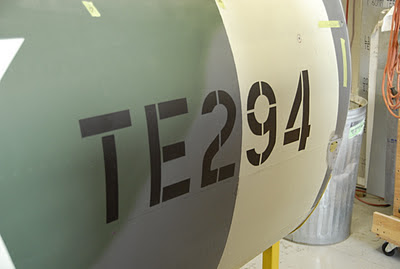- An update on the Mk IX Spitfire in Comox, British Columbia
As the dust settles at the close of the flying season and the last planes roll in off the tarmac to begin a season of periodic inspections and annual maintenance, the buzz of activity truly never decreases; it simply shifts from flight ops to repair ops.
However, on the restoration side of the house, it’s business as usual and nothing can be further from the truth than the Roseland Spitfire project situated out on the west coast.
Often forgotten or perhaps not widely known to many of our followers from parts east of British Columbia and beyond, the Roseland Spitfire restoration project, has become somewhat of a common activity in and around the air base of 19 Wing Comox. Visitors whom come to the Comox Air Force Museum frequently ask for it by name adding that a quick glance at the aircraft would make their visit all the more worthwhile. It isn’t a large crowd we draw but still a following of interested aviation aficionados who deserve and would appreciate regular updates on the progress.
Which leads to this important and overdue blog entry. To recap, the project came under ownership of Vintage Wings of Canada (VWC) effective 1 April 2009 through a purchase agreement with the Department of National Defence (DND), who wished to see through the project to completion and sought out a reputable organization known for its restoration capability to do it.
The Spitfire, formerly referred to as the ‘Y2-K Spitfire’ is, today, known as the Roseland Spitfire in dedication to Arnold ‘Rosy’ Roseland. Roseland first flew the Y2-K Spitfire in March 1944 during his service with 442 Squadron. Like all of the VWC collection, each aircraft is dedicated to a Canadian aviator of great historical significance because of their accomplishments achieved or the sacrifices made during Second World War. Roseland is one such aviator who perished while flying a support mission for the Canadian Army in a spitfire.
The aim
of the Roseland Spitfire restoration project has always been and continues to be to return this celebrated warbird to flying condition in the exact colours depicting 442 Squadron during the WWII. Comox is now home to the current 442 Squadron, a Search and Rescue squadron operating Cormorant helicopters and Buffalo aircraft.
The planes and operations may have changed but history remains and is ours to embrace and commemorate, the mission of Vintage Wings through the restoration of vintage aircraft of historical Canadian significance.
Over the past 18 to 24 months, that has been the focus in mind as the west coast restoration team, as they have become known to be, have undertaking the important and necessary task of auditing all existing work at the time of acquisition and conducting a physical inspection on the status of the aircraft and all its part and systems.
Significant development has taken place on the flight control systems, fuel system, canopy and window screen, and the landing gear. Careful cataloguing of parts have been made and, as such, has enable the restoration team to position themselves to be ready to receive the core components – wings, flaps, ailerons and engine. These key parts have been contracted out to various third party organizations where the expertise resides, because in the business in of warbird restoration, there’s a world-wide community of knowledge worth tapping into.
In the meantime, 19 Wing Comox and the Air Force Museum continue to support the project and have advanced the facilities housing the restoration with an extensive building renovation. The expanded and improved space will enable room for the wings to be attached once complete and returned to Comox and provide adequate amenities to the military facility including plumbing, brighter lighting, and office and storage space. Moreover, the team envisions a comfortable viewing area for tourists complete with audio-visual tools and banners to showcase the restoration progress and the history of the Mk IX Spitfire, tail number TE294.
For now, the doors remain closed to the public but make no mistake; the bees are busy in the hive never missing a moment to move the yardstick forward in the restoration advancement.
Continue to check in on this blog for regular updates on the project for now. Soon, a dedicated blog site will be assigned under Vintage Wings Aircraft Restorations.




No comments:
Post a Comment